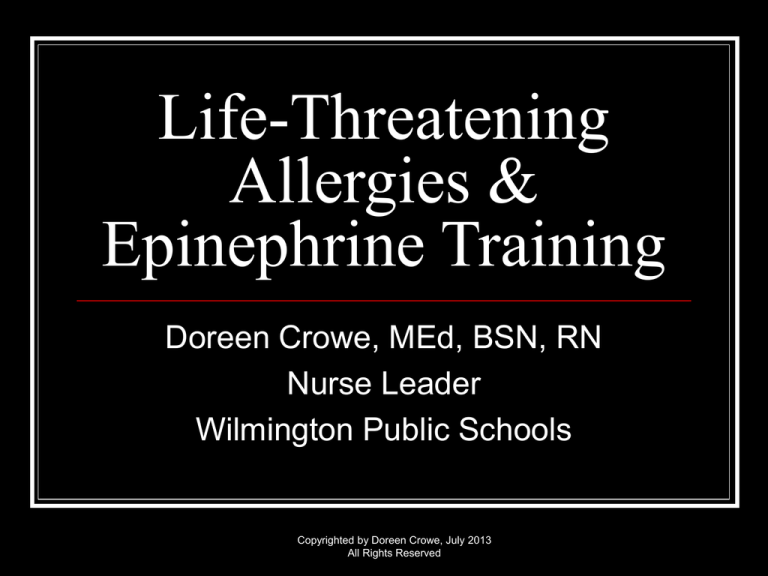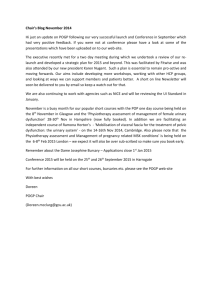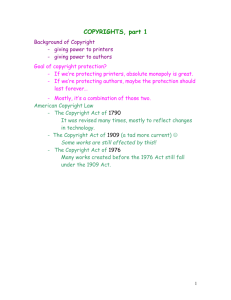
Life-Threatening
Allergies &
Epinephrine Training
Doreen Crowe, MEd, BSN, RN
Nurse Leader
Wilmington Public Schools
Copyrighted by Doreen Crowe, July 2013
All Rights Reserved
PURPOSE
To provide unlicensed* school personnel
with basic knowledge and skills to
administer epinephrine by auto-injection in
a life-threatening situation.
*Refers to Medical license
Copyrighted by Doreen Crowe, July 2013
All Rights Reserved
OBJECTIVES
1.
2.
3.
Identify common causes of allergic
emergencies
Accurately recognize general and
student-specific warning signs of allergic
emergency
Accurately identify student for whom the
epinephrine is prescribed
Copyrighted by Doreen Crowe, July 2013
All Rights Reserved
OBJECTIVES (cont.)
4.
5.
6.
Accurately read and interpret the
emergency medication administration
plan
Correctly follow directions on the
medication administration plan
Accurately read the epinephrine label and
follow directions from the label
Copyrighted by Doreen Crowe, July 2013
All Rights Reserved
OBJECTIVES (cont.)
7.
8.
9.
10.
Administer epinephrine by auto-injector
Safely handle epinephrine in an autoinjector
Accurately describe the school’s plan for
responding to emergencies
Access resources appropriately, including
emergency medical services, school
nurse, parents and physician
Copyrighted by Doreen Crowe, July 2013
All Rights Reserved
WHAT ARE COMMON CAUSES
OF ALLERGIC EMERGENCIES?
Food
Insect Stings
Medication
Latex
Exercise (uncommon)
Copyrighted by Doreen Crowe, July 2013
All Rights Reserved
FOOD
Peanut
Tree Nut (walnuts,
cashew, pecan, hazelnut,
almond)
Milk
Egg
Fish
Shellfish
Soy
Wheat
Eight Foods account
for 90% of all foodallergic reactions
Copyrighted by Doreen Crowe, July 2013
All Rights Reserved
INSECT STINGS
Bees
Wasps
Yellow Jackets
Hornets
Fire Ants
Copyrighted by Doreen Crowe, July 2013
All Rights Reserved
MEDICATION
Anesthesia
Antibiotics
Copyrighted by Doreen Crowe, July 2013
All Rights Reserved
LATEX
Balloons
Gloves
Band-Aids
Copyrighted by Doreen Crowe, July 2013
All Rights Reserved
EXERCISE
Occurs rarely
Copyrighted by Doreen Crowe, July 2013
All Rights Reserved
WHAT IS ANAPHYLAXIS?
A potentially life-threatening medical
condition occurring in allergic
individuals after exposure to an allergen
May occur immediately (seconds) or
delayed (hours)
Individuals with Asthma are at an increased
risk of a severe reaction
Copyrighted by Doreen Crowe, July 2013
All Rights Reserved
WHAT ARE SYMPTOMS OF
ANAPHYLAXIS?
Skin
• Hives
• Itchy rash
• Swelling of
face or
extremities
Stomach
• Abdominal
cramps
• Nausea
• Vomiting
• Diarrhea
Lungs**
• Short of
breath
• Wheezing
• Repetitive
cough
Mouth
• Itchy,
tingling or
swelling of
mouth,
tongue or
lips
•
•
•
•
Heart**
• Faint
• Weak pulse
• Low blood
pressure
• Pale or blue
* *Potentially Life-threatening
Copyrighted by Doreen Crowe, July 2013
All Rights Reserved
Throat**
Itchy throat
Tight throat
Hoarseness
Drooling
Other**
• Anxiety
• Panic
• Itchy,
watery
red eyes
HOW MIGHT A CHILD
DESCRIBE A REACTION?
“My tongue is itching, burning or tingling”
“My mouth feels funny”
“There’s something stuck in my throat”
“My lips feel tight”
“There’s a frog in my throat”
Copyrighted by Doreen Crowe, July 2013
All Rights Reserved
WHAT IS A BIPHASIC
REACTION?
A second wave of
symptoms that may
occur two to four
hours later
Copyrighted by Doreen Crowe, July 2013
All Rights Reserved
WHAT IS EPINEPHRINE?
Epinephrine is the medicine of choice for
treatment of anaphylaxis
Epinephrine is also known as Adrenalin
It quickly constricts blood vessels, raising
blood pressure
It relaxes smooth muscles in lungs to
improve breathing
Copyrighted by Doreen Crowe, July 2013
All Rights Reserved
HOW IS EPINEPHRINE
DELIVERED?
There are 2 Types of
Auto-Injectors:
Older Packaging
Auvi-Q
Epipen
There are two strengths:
Adult 0.3mg
Child 0.15mg
Copyrighted by Doreen Crowe, July 2013
All Rights Reserved
How do you administer
Epinephrine?
Using the 5 Rights:
Right Student
Right Medication
Right Dose
Right Route
Right Time
Copyrighted by Doreen Crowe, July 2013
All Rights Reserved
How do you administer
Epinephrine?
EPIPEN
AUVI-Q
Step 1
<<<<Remove Cap
Pull Red Safety Cover>>>>
Step 2
<<<<Swing & jab into outer thigh
Place against outer thigh,
then press firmly>>>>
Copyrighted by Doreen Crowe, July 2013
All Rights Reserved
RIGHT STUDENT
Identify the student
with a KNOWN
allergy
Accurately read and
interpret student
specific Allergy Action
Plan
Accurately read the
prescription label on
epinephrine package
Copyrighted by Doreen Crowe, July 2013
All Rights Reserved
RIGHT MEDICATION
Epipen/Epipen Jr.
OR
Auvi-Q
Copyrighted by Doreen Crowe, July 2013
All Rights Reserved
RIGHT DOSE
Adult 0.3 mg
Child 0.15mg
Lasts
approximately 15
minutes
Copyrighted by Doreen Crowe, July 2013
All Rights Reserved
RIGHT ROUTE
Large Outer Thigh
May be administered
through clothing
Hold in place for 5-10
seconds
Remove carefully
Massage area where
administered
Copyrighted by Doreen Crowe, July 2013
All Rights Reserved
RIGHT TIME
Student is in
Anaphylaxis
Copyrighted by Doreen Crowe, July 2013
All Rights Reserved
EPIPEN STORAGE &
HANDLING
Properly store at room temperature
Color in window will be clear
Avoid accidental injection to yourself or
you will require immediate attention at an
Emergency Room
Note time administered & give to
Emergency Medical Services upon arrival
Copyrighted by Doreen Crowe, July 2013
All Rights Reserved
SCHOOL PROTOCOL
1.
2.
3.
4.
5.
Call 9-911 from a school phone
Specify the problem: “A student is in
Anaphylaxis & was given Epinephrine”
Specify entrance
Note time of Epinephrine administration &
hand over to EMS upon arrival
Call parent to meet student at closest
medical facility
Copyrighted by Doreen Crowe, July 2013
All Rights Reserved
LIABILITY
Epipen Trained personnel are protected by
the Good Samaritan law
Refresher training is renewable annually
Copyrighted by Doreen Crowe, July 2013
All Rights Reserved
APPROPRIATE RESOURCES
School Nurse
School Physician
Parent
Emergency Medical Services (EMS)
Copyrighted by Doreen Crowe, July 2013
All Rights Reserved
“There is no cure for food
allergies. Strict avoidance of
the offending allergen is the key
to preventing a life-threatening
reaction.”
Copyrighted by Doreen Crowe, July 2013
All Rights Reserved
REFERENCES
http://www.foodallergy.org
Managing Life Threatening Food Allergies in Schools, 2002,
Massachusetts Department of Education, available at
http://www.doe.mass.edu/cnp/news02/allergy.pdf
American Academy of Allergy, Asthma and Immunology,
Anaphylaxis in Schools and Other Child-Care Settings,
available at
http://www.aaaai.org/media/resources/academy_statements/
position_statements/ps34.asp
Massachusetts Department of Public Health: School Health
Unit
http://www.epipen.com
http://www.auvi-q.com
Copyrighted by Doreen Crowe, July 2013
All Rights Reserved
COURSE COMPLETION
1.
2.
Please take the Post-Test
located on the Wilmington
University webpage
Then see a School Nurse to
demonstrate proper
Epinephrine administration
with a training device
Thank You!
Copyrighted by Doreen Crowe, July 2013
All Rights Reserved



